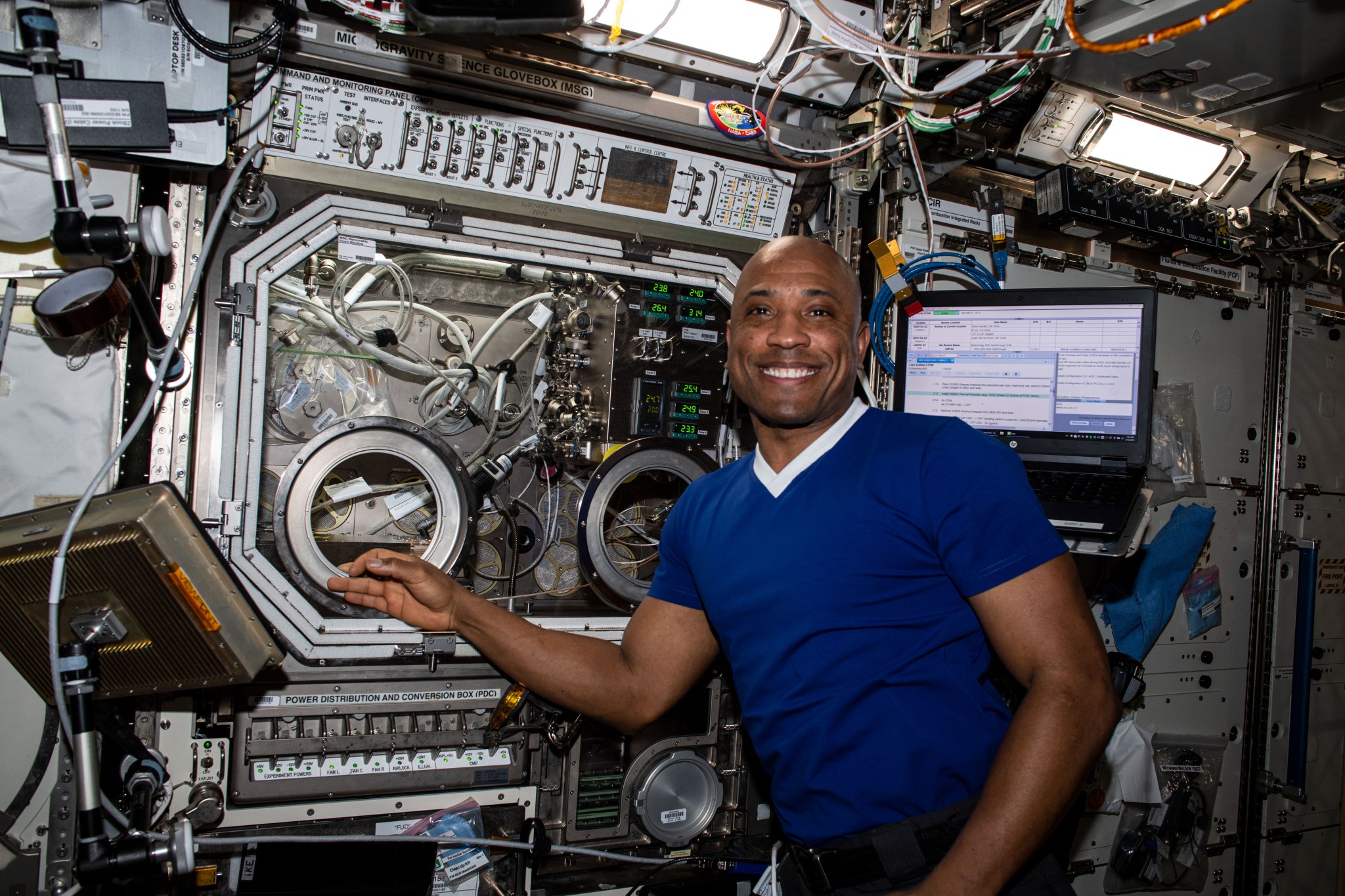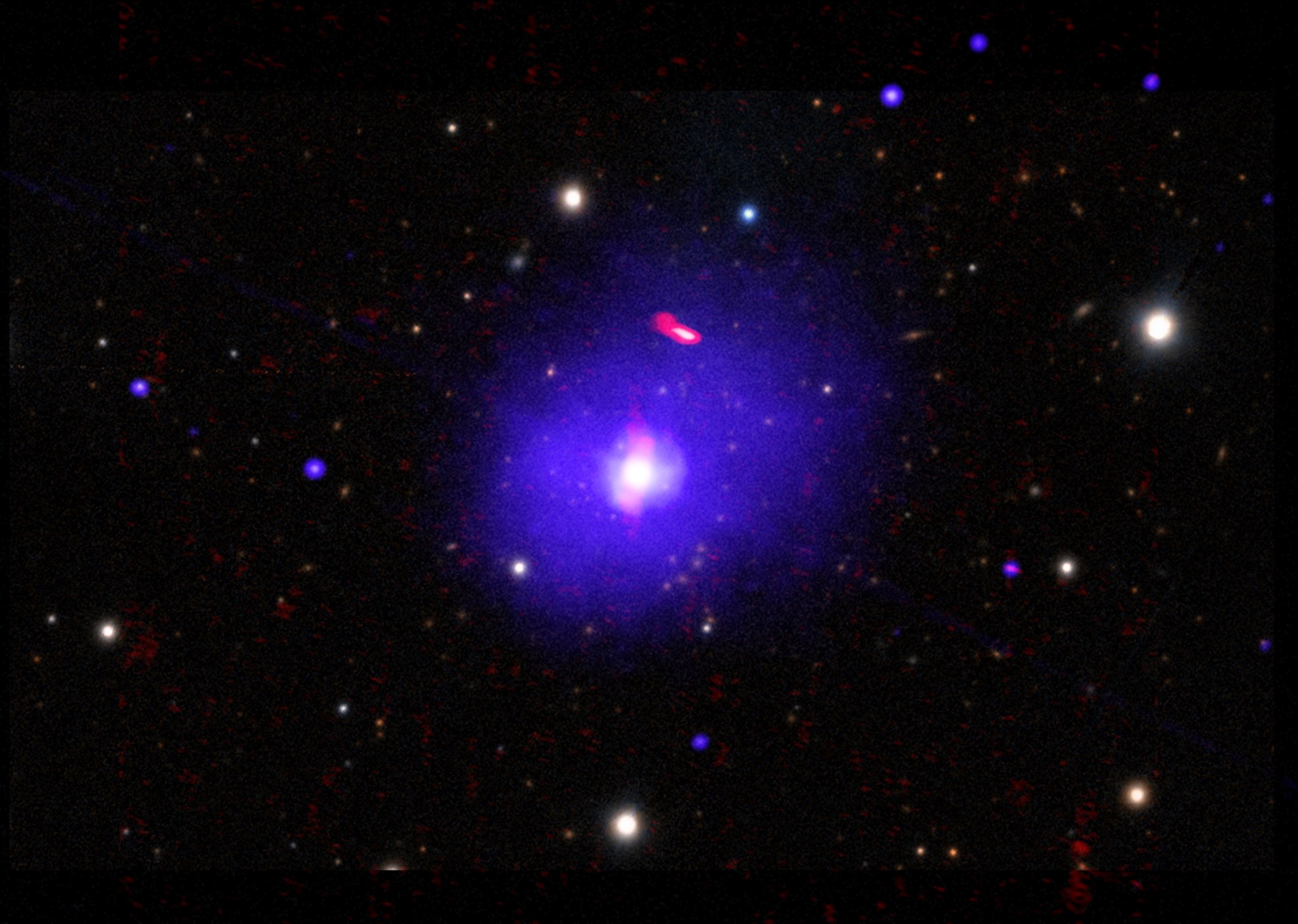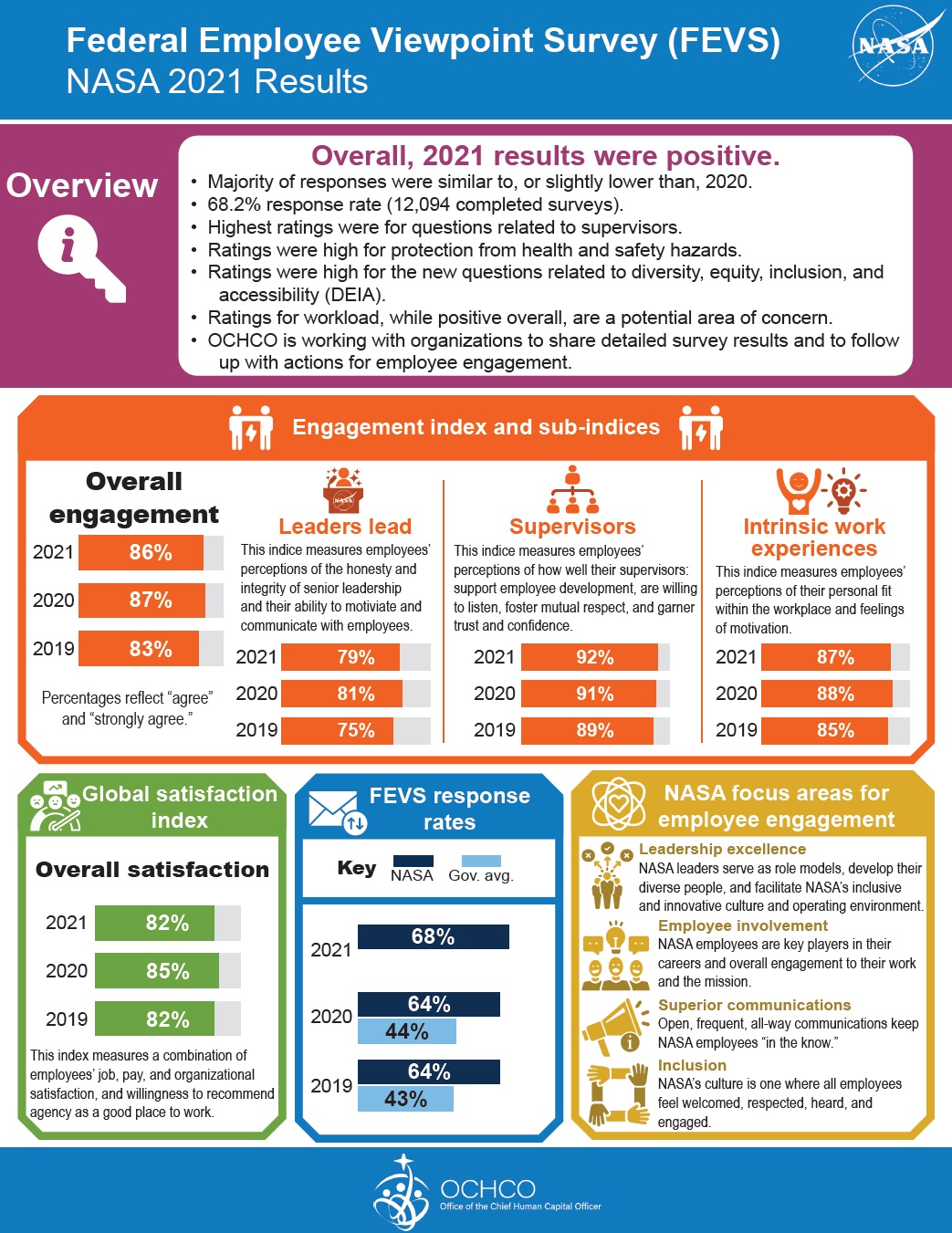In This Week’s Star
- NASA Reveals Webb Telescope’s First Images of Unseen Universe
- Microgravity Science Glovebox Celebrates 20 Years of Success
- Chandra Shows Giant Black Hole Spins Slower Than Its Peers
- Marshall to Host Summer Mentoring Event
- Marshall Civil Servants Encouraged to Take Part in Employee Viewpoint Survey
- 2022 Feds Feed Families Food Drive Continues Through Aug. 31
- OSIRIS-REx Data from Asteroid Bennu Highlighted on ‘This Week at NASA’
NASA Reveals Webb Telescope’s First Images of Unseen Universe
The dawn of a new era in astronomy is here as the world gets its first look at the full capabilities of NASA’s James Webb Space Telescope, a partnership with the European Space Agency and the Canadian Space Agency.
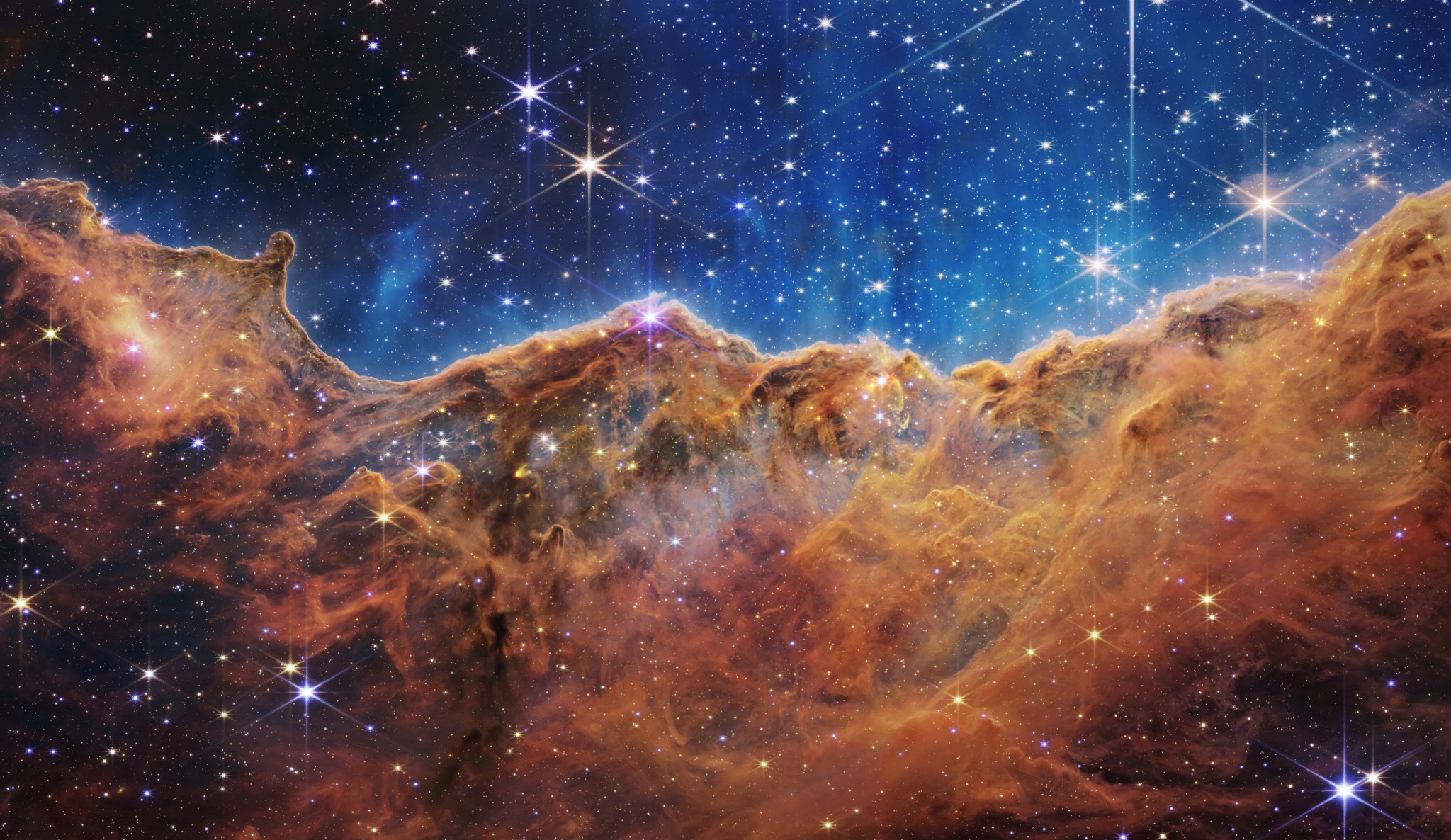
Called the Cosmic Cliffs, Webb’s seemingly three-dimensional picture looks like craggy mountains on a moonlit evening. In reality, it is the edge of the giant, gaseous cavity within NGC 3324, and the tallest “peaks” in this image are about 7 light-years high. The cavernous area has been carved from the nebula by the intense ultraviolet radiation and stellar winds from extremely massive, hot, young stars located in the center of the bubble, above the area shown in this image.
The blistering, ultraviolet radiation from the young stars is sculpting the nebula’s wall by slowly eroding it away. Dramatic pillars tower above the glowing wall of gas, resisting this radiation. The “steam” that appears to rise from the celestial “mountains” is actually hot, ionized gas and hot dust streaming away from the nebula due to the relentless radiation.
Webb reveals emerging stellar nurseries and individual stars that are completely hidden in visible-light pictures. Because of Webb’s sensitivity to infrared light, it can peer through cosmic dust to see these objects. Protostellar jets, which emerge clearly in this image, shoot out from some of these young stars. The youngest sources appear as red dots in the dark, dusty region of the cloud. Objects in the earliest, rapid phases of star formation are difficult to capture, but Webb’s extreme sensitivity, spatial resolution, and imaging capability can chronicle these elusive events.
These observations of NGC 3324 will shed light on the process of star formation. Star birth propagates over time, triggered by the expansion of the eroding cavity. As the bright, ionized rim moves into the nebula, it slowly pushes into the gas and dust. If the rim encounters any unstable material, the increased pressure will trigger the material to collapse and form new stars.
Conversely, this type of disturbance may also prevent star formation as the star-making material is eroded away. This is a very delicate balance between sparking star formation and stopping it. Webb will address some of the great, open questions of modern astrophysics: What determines the number of stars that form in a certain region? Why do stars form with a certain mass?
Webb will also reveal the impact of star formation on the evolution of gigantic clouds of gas and dust. While the effect of massive stars – with their violent winds and high energy – is often apparent, less is known about the influence of the more numerous low-mass stars. As they form, these smaller stars create narrow, opposing jets seen here, which can inject a lot of momentum and energy into the clouds. This reduces the fraction of nebular material that seeds new stars.
Up to this point, scientists have had very little data about the influence of the multitude of young and more energetic low-mass stars. With Webb, they will be able to obtain a full census of their number and impact throughout the nebula.
Located roughly 7,600 light-years away, NGC 3324 was imaged by Webb’s Near-Infrared Camera (NIRCam) and Mid-Infrared Instrument (MIRI).
NIRCam – with its crisp resolution and unparalleled sensitivity – unveils hundreds of previously hidden stars, and even numerous background galaxies.
In MIRI’s view, young stars and their dusty, planet-forming disks shine brightly in the mid-infrared, appearing pink and red. MIRI reveals structures that are embedded in the dust and uncovers the stellar sources of massive jets and outflows. With MIRI, the hot dust, hydrocarbons, and other chemical compounds on the surface of the ridges glow, giving the appearance of jagged rocks.
NGC 3324 was first catalogued by James Dunlop in 1826. Visible from the Southern Hemisphere, it is located at the northwest corner of the Carina Nebula (NGC 3372), which resides in the constellation Carina. The Carina Nebula is home to the Keyhole Nebula and the active, unstable supergiant star called Eta Carinae.
The James Webb Space Telescope is the world’s premier space science observatory. Webb will solve mysteries in our solar system, look beyond to distant worlds around oth-er stars, and probe the mysterious structures and origins of our universe and our place in it. Webb is an international program led by NASA with its partners, ESA (European Space Agency) and CSA (Canadian Space Agency).
NASA Headquarters oversees the mission for the agency’s Science Mission Directorate. NASA’s Goddard Space Flight Center in Greenbelt, Maryland, manages Webb for the agency and oversees work on the mission performed by the Space Telescope Science Institute, Northrop Grumman, and other mission partners. In addition to Goddard, several NASA centers contributed to the project, including the agency’s Johnson Space Center in Houston, Jet Propulsion Laboratory (JPL) in Southern California, Marshall Space Flight Center in Huntsville, Alabama, Ames Research Center in California’s Silicon Val-ley, and others.
NIRCam was built by a team at the University of Arizona and Lockheed Martin’s Ad-vanced Technology Center.
MIRI was contributed by ESA and NASA, with the instrument designed and built by a consortium of nationally funded European Institutes (The MIRI European Consortium) in partnership with JPL and the University of Arizona.
For a full array of Webb’s first images and spectra, including downloadable files, please visit: https://webbtelescope.org/news/first-images Credits: NASA, ESA, CSA, and STScI
The full set of the telescope’s first full-color images and spectroscopic data, which uncover a collection of cosmic features elusive until now, released July 12, is available here.
“Today, we present humanity with a groundbreaking new view of the cosmos from the James Webb Space Telescope – a view the world has never seen before,” said NASA Administrator Bill Nelson. “These images, including the deepest infrared view of our universe that has ever been taken, show us how Webb will help to uncover the answers to questions we don’t even yet know to ask; questions that will help us better understand our universe and humanity’s place within it.
“The Webb team’s incredible success is a reflection of what NASA does best. We take dreams and turn them into reality for the benefit of humanity. I can’t wait to see the discoveries that we uncover – the team is just getting started!”
NASA explores the unknown in space for the benefit of all, and Webb’s first observations tell the story of the hidden universe through every phase of cosmic history – from neighboring planets outside our solar system, known as exoplanets, to the most distant observable galaxies in the early universe.
“This is a singular and historic moment,” said Thomas Zurbuchen, associate administrator for NASA’s Science Mission Directorate. “It took decades of drive and perseverance to get us here, and I am immensely proud of the Webb team. These first images show us how much we can accomplish when we come together behind a shared goal, to solve the cosmic mysteries that connect us all. It’s a stunning glimpse of the insights yet to come.”
“We are elated to celebrate this extraordinary day with the world,” said Greg Robinson, Webb program director at NASA Headquarters. “The beautiful diversity and incredible detail of the Webb telescope’s images and data will have a profound impact on our understanding of the universe and inspire us to dream big.”
Webb’s first observations were selected by a group of representatives from NASA, ESA, CSA, and the Space Telescope Science Institute. They reveal the capabilities of all four of Webb’s state-of-the-art scientific instruments.
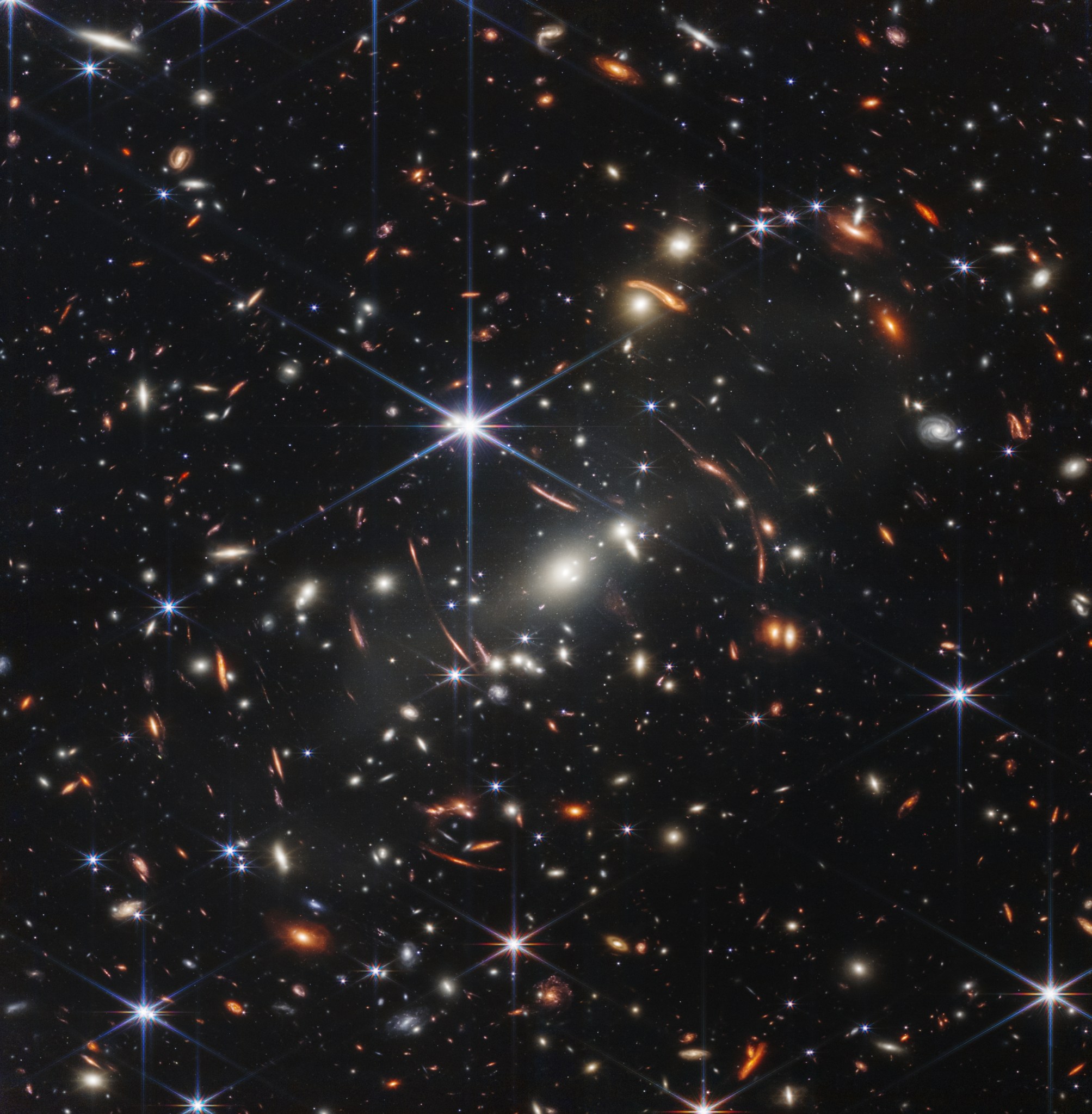
Thousands of galaxies – including the faintest objects ever observed in the infrared – have appeared in Webb’s view for the first time. This slice of the vast universe is approximately the size of a grain of sand held at arm’s length by someone on the ground.
This deep field, taken by Webb’s Near-Infrared Camera (NIRCam), is a composite made from images at different wavelengths, totaling 12.5 hours – achieving depths at infrared wavelengths beyond the Hubble Space Telescope’s deepest fields, which took weeks.
The image shows the galaxy cluster SMACS 0723 as it appeared 4.6 billion years ago. The combined mass of this galaxy cluster acts as a gravitational lens, magnifying much more distant galaxies behind it. Webb’s NIRCam has brought those distant galaxies into sharp focus – they have tiny, faint structures that have never been seen before, including star clusters and diffuse features. Researchers will soon begin to learn more about the galaxies’ masses, ages, histories, and compositions, as Webb seeks the earliest galaxies in the universe.
This image is among the telescope’s first-full color images Credits: NASA, ESA, CSA, and STScI
Click below to read more on each of the first images released.
The release of Webb’s first images and spectra kicks off the beginning of Webb’s science operations, where astronomers around the world will have their chance to observe anything from objects within our solar system to the early universe using Webb’s four instruments.
The James Webb Space Telescope launched Dec. 25, 2021, on an Ariane 5 rocket from Europe’s Spaceport in French Guiana, South America. After completing a complex deployment sequence in space, Webb underwent months of commissioning where its mirrors were aligned, and its instruments were calibrated to its space environment and prepared for science.
The James Webb Space Telescope is the world’s premier space science observatory. Webb will solve mysteries in the solar system, look beyond to distant worlds around other stars, and probe the mysterious structures and origins of our universe and our place in it.
NASA Headquarters oversees the mission for the agency’s Science Mission Directorate. NASA’s Goddard Space Flight Center manages Webb for the agency and oversees work on the mission performed by the Space Telescope Science Institute, Northrop Grumman, and other mission partners. In addition to Goddard, several NASA centers contributed to the project, including the agency’s Johnson Space Center, Jet Propulsion Laboratory, Marshall Space Flight Center, Ames Research Center, and others.
Read more about Marshall’s work for the mission here.
Microgravity Science Glovebox Celebrates 20 Years of Success
By Wayne Smith
Thinking outside the box propels many NASA innovations for missions exploring space and improving life on Earth. But thinking – or working – inside the box makes scientific discoveries possible aboard the International Space Station.
The box is the Microgravity Science Glovebox, or MSG, which celebrated its 20th anniversary aboard the space station July 8. Managed by NASA’s Marshall Space Flight Center, the unique lab is designed to closely simulate working conditions on the ground.
Since MSG’s installation, space station crews and scientists around the globe have conducted 63 experiments, many operating multiple times. The glovebox has accumulated 70,000 hours of operational time.
“MSG is like a workhorse, a tank,” said Chris Butler, payload integration manager for the glovebox at Marshall, who has worked with the hardware since before it was launched to the space station in 2002. “We’re 10 years past its expected life expectancy, and it’s been certified through 2030.”
MSG is a sealed facility that provides an enclosed space for investigations conducted in the low-gravity, or microgravity, environment created on the space station. The glovebox offers a safe environment for the crew to conduct research with liquids, flames, and particles used as a part of everyday research on Earth. The glovebox features two levels of containment to protect crew members as they conduct investigations 250 miles above Earth. It contains any leaks, and an air filtration system captures aerosols and other potentially harmful particles.
The European Space Agency developed MSG in a joint venture with NASA. The glovebox is roughly 3 feet wide and 2 feet high, with a 9-cubic-foot workspace where crew members use built-in glove ports to safely manipulate research elements. Its integrated power, data acquisition, and communications systems permit researchers to pursue small and midsized investigations in the areas of fluid physics, combustion science, biotechnology, materials science, and more. Crews are trained to operate MSG at NASA’s Johnson Space Center. The Marshall team oversees all payloads from its Payload Operations Integration Center.
MSG allows scientists to explore the effects of microgravity in the fields of physical and biological science, making it central hardware for hands-on research. Crews can view their work from a large acrylic window and a camera inside the glovebox makes it possible for scientists on Earth to watch experiments as they are performed.
Space station partners have also commissioned a second dedicated facility, the Life Sciences Glovebox, to ease demand. Marshall also manages the Life Sciences Glovebox, which was built specifically for biological research and installed on the space station in 2018.
The MSG Project Office at Marshall was responsible for technical oversight of European Space Agency’s development effort. NASA handed over management of MSG to the Marshall team after its delivery to the space station. A glovebox at Marshall permits the testing of materials and the evaluation of safety threats before crews conduct experiments in microgravity.
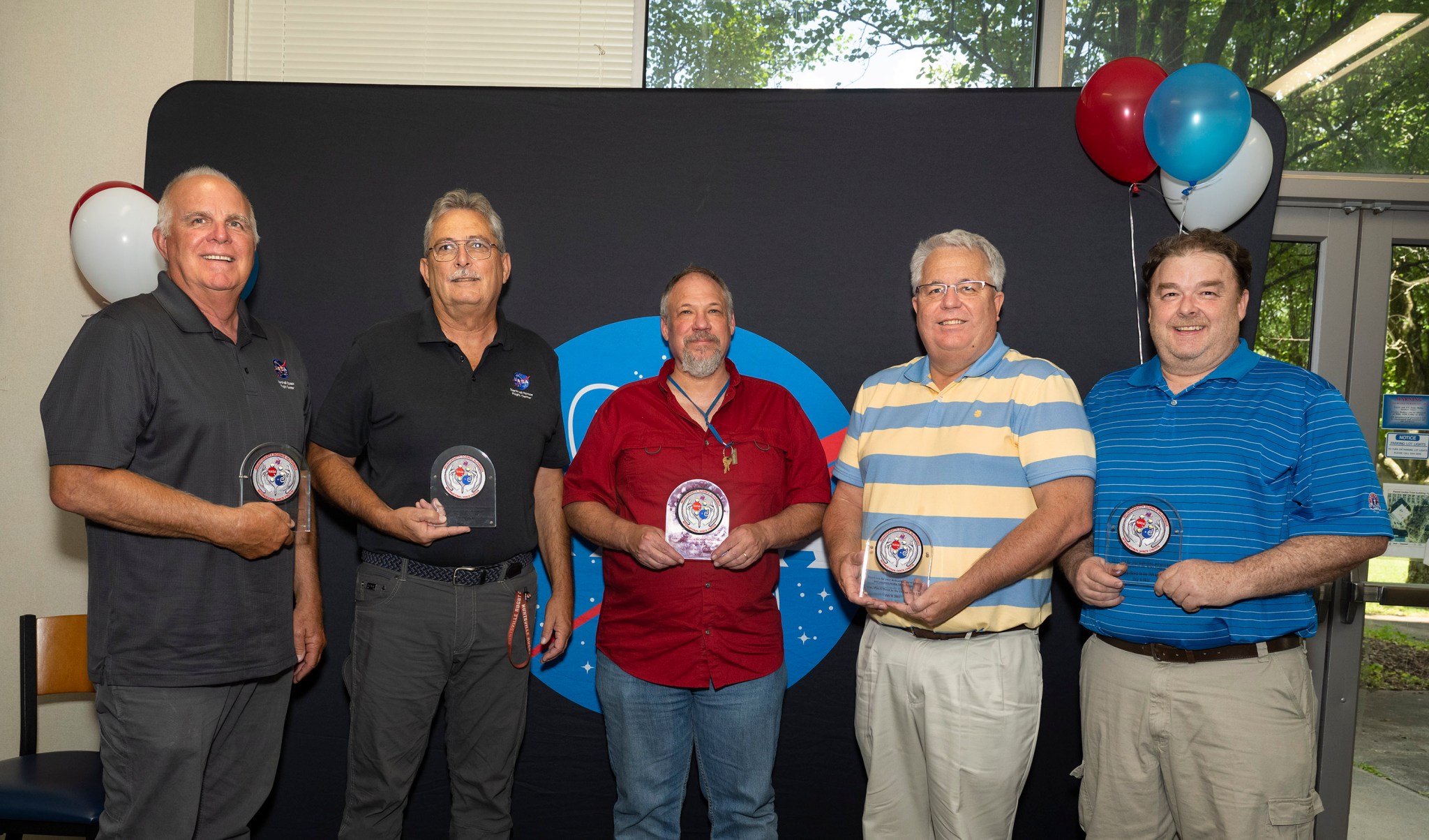
Phillip Bryant, lead test systems engineer for the Marshall team, has worked with the MSG from the development stages, having spent several months in Europe during design and testing. He serves as an around-the-clock resource to answer questions for issues that might arise with the glovebox. Bryant says the 20-year anniversary is more than just a number for him. “I worked with the gloveboxes all the way through development and verifications, and I support all the safety reviews and any issues in orbit,” Bryant said. “These are my babies.”
Future experiments with MSG include studies in fiberoptics, combustion, fluid flow, and semiconductor growth. Scientific investigations on the space station are also crucial as NASA prepares to return human explorers to the Moon and journey on to Mars.
The Human Exploration Development and Operations Office at Marshall held a celebration July 8, commemorating the 20th anniversary of MSG. The anniversary comes less than a month after NASA recognized another extraordinary milestone of a project Marshall manages. EXPRESS Racks – properly known as “EXpedite the PRocessing of Experiments to the Space Station” multipurpose payload shelving units – reached 1 million hours of cumulative service on the space station June 14. The racks were developed, built, and tested at Marshall.
Ginger Flores, director of Marshall’s Human Exploration Development and Operations Office at Marshall, said the center’s involvement with MSG enables research from scientists that might not have been possible otherwise.
“The project team at Marshall has been responsible for integrating all of the experiments into MSG since 2002,” Flores said, who is also a former MSG project manager. “This is important science for future space exploration and to make life better on Earth. Its success story is a direct result of the decades of dedication of this team.”
Smith, a Media Fusion employee, supports Marshall’s Office of Strategic Analysis & Communications.
Chandra Shows Giant Black Hole Spins Slower Than Its Peers
Astronomers have made a record-breaking measurement of a black hole’s spin, one of two fundamental properties of black holes. NASA’s Chandra X-ray Observatory shows this black hole is spinning slower than most of its smaller cousins.
This is the most massive black hole with an accurate spin measurement and gives hints about how some of the universe’s biggest black holes grow.
H1821+643 is a quasar powered by a supermassive black hole, located about 3.4 billion light years from Earth. Astronomers used Chandra to determine the spin of the black hole in H1821+643, making it the most massive one to have an accurate measurement of this fundamental property, as described in a press release. Astronomers estimate the actively growing black hole in H1821+643 contains between about three and 30 billion solar masses. By contrast, the supermassive black hole in the center of the Milky Way galaxy weighs about four million suns.
A composite image of H1821+643 contains X-rays from Chandra (blue) that have been combined with radio data from NSF’s Karl G. Jansky Very Large Array (red) and an optical image from the PanSTARRS telescope on Hawaii (white and yellow). The researchers used nearly a week’s worth of Chandra observing time, taken over two decades ago, to obtain this latest result. The supermassive black hole is in the bright dot in the center of the radio and X-ray emission.
Because a spinning black hole drags space around with it and allows matter to orbit closer to it than is possible for a non-spinning one, the X-ray data can show how fast the black hole is spinning. The spectrum – that is, the amount of energy as a function wavelength – of H1821+643 indicates the black hole is rotating at a modest rate compared to other, less massive ones that spin close to the speed of light.
Why is the black hole in H1821+432 spinning only about half as fast as the lower mass cousins? The answer may lie in how these supermassive black holes grow and evolve. This relatively slow spin supports the idea that the most massive black holes, such as H1821+643, undergo most of their growth by merging with other black holes, or by gas being pulled inwards in random directions when their large disks are disrupted.
Supermassive black holes growing in these ways are likely to often undergo large changes of spin, including being slowed down or wrenched in the opposite direction. The prediction is that the most massive black holes should be observed to have a wider range of spin rates than their less massive relatives.
On the other hand, scientists expect less massive black holes to accumulate most of their mass from a disk of gas spinning around them. Because such disks are expected to be stable, the incoming matter always approaches from a direction that will make the black holes spin faster until they reach the maximum speed possible, which is the speed of light.
A paper describing these results appears in the Monthly Notices of the Royal Astronomical Society and is available at https://arxiv.org/abs/2205.12974 The authors are Julia Sisk-Reynes, Christopher Reynolds, James Matthews, and Robyn Smith, all from the Institute of Astronomy at the University of Cambridge in the UK.
NASA’s Marshall Space Flight Center manages the Chandra program. The Smithsonian Astrophysical Observatory’s Chandra X-ray Center controls science operations from Cambridge, Massachusetts, and flight operations from Burlington, Massachusetts.
Marshall to Host Summer Mentoring Event
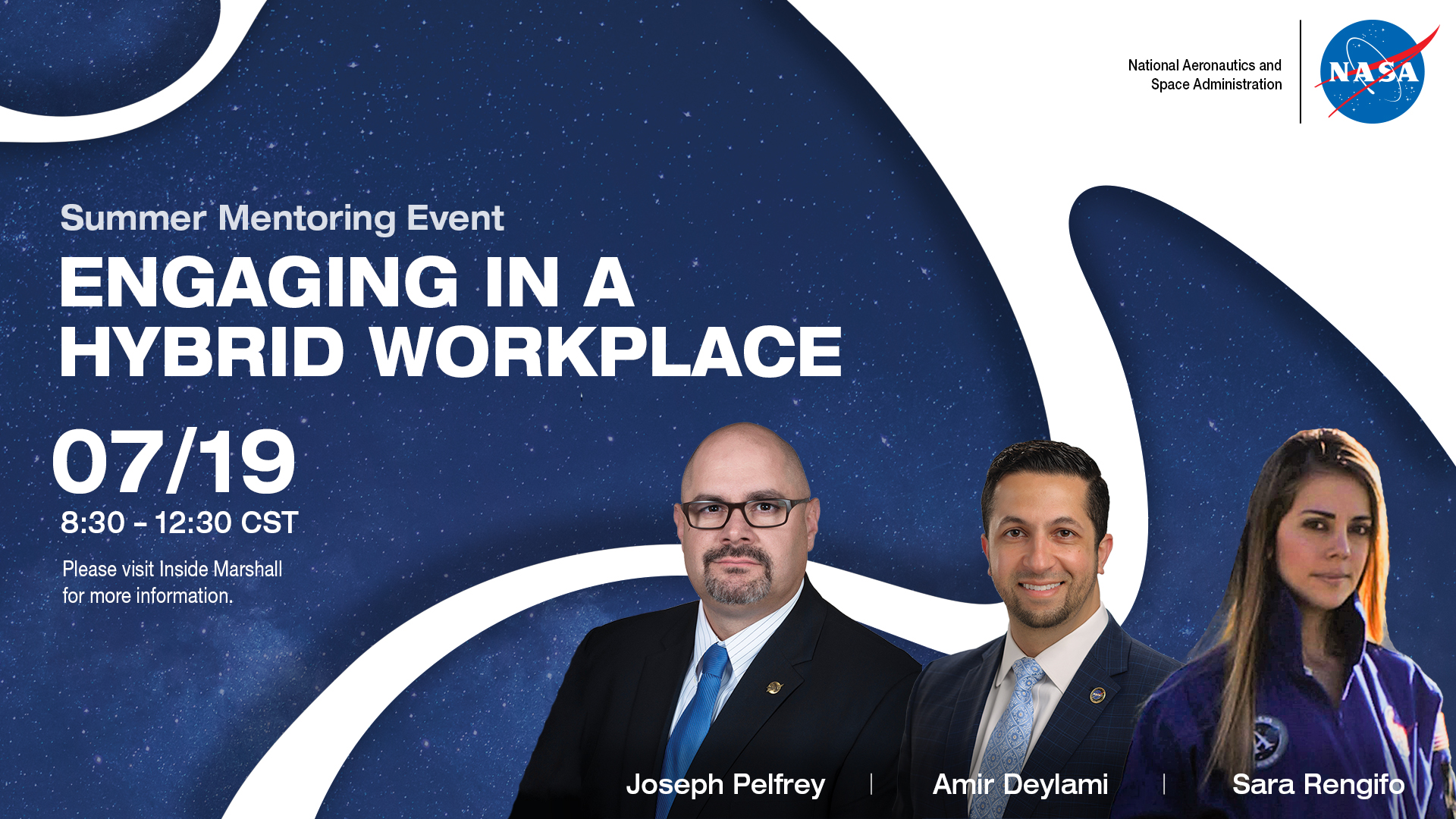
NASA’s Marshall Space Flight Center will host a mentoring event – titled “Engaging in a Hybrid Workplace” – on July 19. The hybrid event is scheduled for 8:30 a.m. to 12:30 p.m. and will feature virtual opening remarks and keynote addresses, with in-person and virtual options available for mentoring sessions. The event will explore the challenges of a hybrid workplace, provide valuable mentorship from experienced leadership, and facilitate a venue to collaborate and network. Keynote speakers will be Amir Deylami, associate director at NASA’s Ames Research Center, and Sara Rengifo, tribology and metrology engineer at Marshall. Four breakout sessions – each featuring two mentors – will follow. For registration details and more information, visit here. (NASA)
Marshall Civil Servants Encouraged to Take Part in Employee Viewpoint Survey
Civil service team members at NASA’s Marshall Space Flight Center are encouraged to participate in the 2022 Federal Employee Viewpoint Survey, which concludes Aug. 2.
“NASA has been ranked as the Best Place to Work in the Federal Government among large agencies for several years in a row,” said Susan Whitfield, director of human resources in Marshall’s Office of Human Capital. “Part of the reason for this distinction is NASA’s attention to the workforce. From frontline supervisors to leaders at the highest level, we are committed to taking care of our employees.”
The survey is a key element of that regard, she said. “The FEVS survey provides a tool to collect direct input from employees about a variety of workplace conditions, including work alignment, leadership practices, engagement, training, and development, career advancement opportunities, work-life balance, and more. The survey enables NASA to identify trends, with an eye toward always improving.”
Every NASA civil servant should have received a personal link to the survey via email. Anyone who has not yet received the email should contact NSSC-Survey@mail.nasa.gov.
Supervised by the Office of Personnel Management using software administered by the NASA Shared Services Center, the newly streamlined survey is open to full-time and part-time civil servants. It is designed to provide administrators with insight about employee satisfaction and gives team members opportunities to suggest ways to improve workflows, morale, and productivity across the federal government.
The email-based survey is voluntary, and should take no more than 15-20 minutes. All responses are confidential. Eligible civil service employees who have not yet received an email invitation should contact OPM at EVNN@opm.gov.
A list of frequently asked questions is available on Inside Marshall. Learn more about the survey here.
2022 Feds Feed Families Food Drive Continues Through Aug. 31
Employees at NASA’s Marshall Space Flight Center can help those in the Huntsville community who are food insecure through the annual Feds Feed Families food drive.
The food drive is a voluntary governmentwide and nationwide effort to collect and donate food for those in need. Since the campaign began in 2009, federal workers have donated and collected more than 99 million pounds of food and other nonperishable items to support families at risk of hunger across America. The 2022 campaign at NASA focuses on summer giving, from July 1 through Aug. 31. It also encourages federal employees to donate year-round.
Marshall employees donated more than 22,000 pounds of food during last year’s campaign, according to human resources specialist Kenneth Smiley, who is the center’s representative this year. He said the Feds Feed Families food drive offers Marshall team members an impactful opportunity to help those dealing with food insecurity.
“In my opinion, this year’s Fed Feeds Families food drive campaign takes on even greater importance this year in light of the rise in the cost of purchasing food,” Smiley said. “Our contributions can make a measurable difference in the lives of those dealing with this challenge.”
Smiley, who joined Marshall’s Talent Management Office in 2016, said he is a longtime supporter of outreaches such as the food drive by volunteering in food pantries in communities where he has lived.
“Huntsville ranks as one of the best communities where I have lived and one of the key reasons is due to the quality of people who live here,” Smiley said. “Giving is woven in the fabric of our community and Feds Feed Families allows for this attribute to once again be on display as we support households navigating the challenge of food insecurity.”
Each week of the campaign will have a different theme. The theme for July 10-16 is Rural Hunger. One in 10 rural families face poverty, according to the U.S. Department of Agriculture. In Alabama, 788,250 people were food insecure in 2019, before COVID-19, according to the USDA.
This year’s campaign will be carried out virtually and follow safety protocols resulting from workplace flexibilities and the pandemic. It also includes a greater emphasis on online donations. Employees who choose to attend in-person activities – such as volunteering at a food bank or gleaning – are advised to follow guidance from NASA, the Centers for Disease Control and Prevention, and their respective state’s department of health for food safety, prevention, and infection control.
NASA’s goal is to collect 160,000 pounds in donations this year. Employees may contribute to participating food banks and pantries in the following ways:
- Purchase food online and have it delivered directly to a food bank or pantry.
- Drop off food donations at a local food bank or pantry.
Employees can record their donations to a food pantry or food bank online. Visit the Feds Feed Families Hub to learn more about getting involved, recording donations, locating gleaning events, and sharing success stories.
OSIRIS-REx Data from Asteroid Bennu Highlighted on ‘This Week at NASA’
An update on data collected from the OSIRIS-REx spacecraft at asteroid Bennu
is featured in “This Week @NASA,” a weekly video program broadcast on NASA-TV and posted online.
After analyzing data from the OSIRIS-REx spacecraft’s Touch-and-Go sample collection event at asteroid Bennu in October 2020, scientists were surprised to learn that the spacecraft’s arm sank almost half a meter into the asteroid. This was far deeper than expected and confirmed that Bennu’s surface is incredibly weak.
It turns out that the surface material on Bennu is so loosely packed that stepping onto the asteroid might feel a bit like stepping into one of those pits filled with plastic balls that you might see at a kids’ play area. OSIRIS-REx collected a handful of material and kicked up roughly six tons of loose rock during the Touch-and-Go event. It will return its sample of Bennu to Earth in September 2023.
OSIRIS-REx is the third mission in NASA’s New Frontiers Program. NASA’s Marshall Space Flight Center manages New Frontiers for the agency’s Science Mission Directorate.
View this and previous episodes at “This Week @NASA” on NASA’s YouTube page.
Producer: Andre Valentine
Editor: Lacey Young
Music: Universal Production Music Credits: NASA


























